Even if you’ve been able to put a check mark next to that spanking-new website on your marketing to-do list, get out your eraser. Your work has only just begun. A successful website is never once-and-done. It needs to remain fresh and relevant, adapting to evolving user habits, competitive market dynamics, and search engine algorithms. Creating an experience that is meaningful to your audience is vital. However, you also need to balance user experience with promoting your expertise and distinguishing your organization.
Here, we’ve collected 15 common practices that could be negatively impacting your website right now. But, don’t worry; this post is not all bad news. Any list of problems is useless unless it provides solutions. So, we’re also offering actions you can begin to take today to make your site work harder for you and give people a reason to return.
1. Your website is not responsive
Having a mobile-friendly website (what we call “responsiveness”) is no longer a nice-to-have. It’s a must-have. Sixty-five percent of all digital time in the US is spent on mobile devices. More than half of all web searches (60%) are done via mobile devices. Those numbers will continue to grow. Way back in April 2016, Google algorithms began favoring responsive sites over unresponsive ones during smart phone searches. Shortly thereafter, Google adopted a mobile-first indexing strategy. Mobile-first indexing now bases website ranking and indexing from the mobile version of a site instead of the desktop version. All websites should be mobile-friendly or risk falling lower on Google’s search rankings. Luckily, many platforms, like WordPress, have templates (themes) available with responsiveness already built-in. That’s often more affordable than hiring a programmer to recreate a separate mobile-friendly version of your site. It’s time to make the move.
2. It’s all about you
If your website messaging is all about you, you’re missing your audience. Prospects won’t care about you until they know that you understand and care about them. Keep in mind that people are visiting your site because they are needy. Quite often, they need to feel an emotional — maybe even empathetic — connection in your message. They need to know that you understand them, their pain points, and what keeps them up at night. And, they need to believe that you can make their lives easier. They will not get it from, “We do this” and “We do that.” Instead of talking about yourself, try replacing the “we”s and “us”s in your messaging with “you”s.
3. You’re missing the emotional connections
Empathy can be your most powerful marketing tool. You have less than eight seconds to capture your audience. So, you need to get them to immediately think, “Hey, they get me!” within those precious few seconds. Otherwise, you’ll lose them before you get them. To make those emotional connections, begin with a 30,000-foot view of why you do things differently and why it really matters to your audience. You’re likely solving a problem or satisfying a need that transcends your products or services. Remember, most purchasing decisions are emotional ones. So, it’s not about what you’re selling; it’s what your customer gains from it.
4. Complicated navigation
Website navigation should be simple and intuitive. Vital information should be no more than three (preferably two) clicks from your home page. And, visitors should never be more than one click away from your home page from everywhere on your site. Don’t give visitors too many options. Remember, more information is not necessarily better. It’s more about quality and brevity. Try to keep your top-level navigation as simple as you can. For pages that are less important, relegate them to secondary menus, sidebars, or footers. And be sure to make it easy for people to contact you. Keep the contact forms simple and easy to find. The more personal information you request, the less likely they will be to contact you.
5. Too many distractions
Social media feeds. Calls to action. Pop-up registration forms. Support chats. While these tactics are important, getting too heavy-handed with them will do little more than clutter the user experience. Each web page should have one primary purpose. If you have too much going on, people won’t know where to begin and become overwhelmed. Ask yourself what one thing do you want visitors to do. Simplify your layout, include only relevant information, and never lose sight of that main goal, whether it’s to capture contact info, offer a download, or drive people to another area of the site. If you have one primary call to action on your home page, don’t bother with sliding carousels. Most visitors never make it to the last one and having too many secondary messages will bury the important ones. But, not everyone is the same. Some prospects are more analytical and want to absorb as much information as possible. So, be sure not to lose sight of those who want to explore.
6. No downloadable assets with landing pages
If you’re getting traffic to your site, that’s great. But, that’s only the first step. Many businesses spend thousands driving people to their websites with no real plan of what to do with them once they get there. Downloadable assets can be a great way to turn that traffic into leads. The best way is to offer information that educates and is meaningful to them. Checklists, whitepapers, and user tips can be very effective freebies. But, you might not get it right the first time. So, be sure that each asset has a dedicated landing page. That way, you can use analytics to determine if people are going to the landing page, but not completing the contact form. In that case, you’ll need to revisit the asset or the messaging. Sometimes a few minor tweaks can make a major difference.
7. You forgot to say, “Thank you.”
If people go to the trouble of providing personal information by submitting a contact form, it’s always a good idea to lead them to a thank you page. A well-executed thank you page, first and foremost, demonstrates your appreciation for their submission. Beyond that, it provides an opportunity to keep people engaged by offering a chance to sign up for a newsletter, a coupon code, exclusive discount, or other related information. Most pages on your website should never be a dead end. Your thank you page should be no exception.
8. Form-over-function design
Design only works with a strategy behind it. Words ALWAYS come first with design and graphics supporting them. Images and, especially, colors have psychological advantages. Certain colors, like orange, work best as call to action buttons. Other colors, like blues, have soothing benefits and can affect the tone of the web experience and might just help people stick around longer. Fast food restaurants tend to use reds, oranges, and yellows to move people in and out quicker. In the same way, your website’s color palette can impact how your traffic behaves. Understand that a typical audience has an attention span of less than ten seconds. Your first impression matters more than anything. Keep sections brief and to the point. Headlines should be concise and meaningful. Don’t overdo it with too many photos or busy animations that add little more than glitz.
9. Your blog is selling instead of sharing
Business blogging is for sharing, not selling. If you’re promoting products and services through your blog, save the selling for another time and place. People visit business blogs to be educated. If they feel they’re being sold, they’ll tune out. Conversely, if they find themselves learning from you, they’ll consider you a trusted resource and be more inclined to jump into your sales funnel when the time is right for them. Moreover, if people visit your blog and see it’s been months since your last post, they’ll see it as a lack of commitment on your part. If you cannot commit to your own business, how committed will you be to theirs? Blogging is not for everyone. While it can be a valuable marketing tool, if you don’t have the time and resources to commit to developing original content, you might be better served by having no blog.
10. Missing internal linking strategy
An internal link is one that leads people to relevant pages within your domain. A good internal linking strategy enables easy navigation of your site, helps establish your information hierarchy, and distributes page authority and ranking power throughout the site. When the search engines crawl your website, they see internal links as a signal that the content you’re linking to is good. So, look for opportunities within your messaging to link to relevant pages in your site. But, make sure any internal links you provide are useful to the audience and help further the story. If you go overboard, people will be quickly annoyed and feel manipulated. Also, set those links to open into new windows or tabs. The last thing you want to do is drive people away from your primary page. This article includes several examples of internal links.
11. You’re making it difficult to share
Creating all that great content would be a wasted effort if you don’t make it easy to share with others. Adding social share and follow buttons to your best content makes it easy for visitors to spread the word about what you do best. Remember, the effectiveness of your content is gauged by how many people find it useful. Why not encourage them to share it across their favorite social media platforms in a single click? Social follow buttons are links directly to your own social media profiles and can help build your online following. Keep in mind that not every visitor to your website is ready to engage you. Social follow buttons enable them to stay connected with you as you feed them content while promoting your subject matter expertise and building your awareness.
12. Missing client testimonials
Nothing promotes a business better than the words of others. If you have clients who have had great experiences, ask them if they are willing to go on record saying so by providing a testimonial for your website. This presents a great opportunity to use their words to tell others how great you are without you blowing your own horn. Once you get permission to use their testimonials on your own site, ask them if they’ll post them as Google reviews. To make it as easy as possible for them, search for your company by name in Google. When your listing appears, click on the “Write a Review” button. When the Google review box pops up, copy the URL out of the address bar. Send your client an e-mail with their testimonial included along with the review link. All they have to do is copy, click, and paste. Don’t forget that one needs a Google account in order to post Google reviews.
13. Staleness
Search engines are constantly indexing websites. If they see that yours has become stale with no changes, they will penalize your rankings. Try to freshen-up your home page on a regular basis. If you have videos, which Google loves to see (it’s no coincidence that they own YouTube), rotate them on a bi-monthly or monthly basis. Make sure your recent blog posts are featured on your home page, as well. Set aside a portion of your home page for service or product feature updates. Better yet, feature a client case studies or success stories. You might be surprised how clients are flattered by the exposure and public appreciation. The more you can demonstrate that you’re keeping your site fresh, the more likely you’ll have return visitors. And, you’ll be keeping the search engines happy.
14. You lost sight of your competition
There’s a lot you can learn from regularly visiting your competitors’ websites and seeing how well you stack up against them. You’ll learn from what they’re doing right and discover ways to demonstrate that you belong in the same market. More importantly, you can learn from what they’re doing wrong and use those mistakes as opportunities to distinguish yourself from them. If your competitors are successful at blogging, look at what topics are gaining the most response and put your own spin on them. Remember, nobody on Earth has your unique experiences. Tap into them and share, share, share.
15. You’re trying to do everything yourself
Unless you do it for a living, taking a home-cooking approach to your marketing will likely show. If outsourcing your marketing is something you don’t think you can afford, think again. Your competitors are taking it seriously and hiring professionals. You should, too. Remember, marketing is an investment and should never be viewed solely as an expense. Instead, focus on the value and cost of inaction. If price is a barrier, see if you can work out a trade in services or a payment plan. The real cost of doing your own website is that it will be obvious to others and likely won’t follow best practices. Furthermore, it will take your time away from making money at what you do best.
Related Posts
8 ways you could be losing customers before you get them (part 1)
Instead of offering tips to get more clients, we’re putting a bit of a twist on things by highlighting ways you could be losing them without even realizing it.
Does it really come down to budget?
Running a successful business relies heavily on managing resources and using them wisely. But certain marketing essentials require investments and should be treated as such. In fact, many of them are prerequisites to profitability.
What’s in a name, anyway?
If your business is like ours, you don’t have a bottomless marketing budget to build awareness of a name that lacks clarity. We have to be more calculated and deliberate.
Keep the change
Evolving technology keeps all of us on our collective toes, makes us more aware of our competitors and presents more opportunities to distinguish ourselves than ever before. Moreover, it adversely impacts those who fail to embrace it.
Unclutter your marketing view
To succeed in marketing, we need to avoid the distractions and focus on the fundamentals. We need to pull ourselves out of the bubble in which we live to see ourselves the way others see us. It’s this uncluttered view that helps bring the clarity and objectivity that lead us to a sound strategy.
True leadership is in knowing when to follow
The more experts you keep in your circle, the better you’ll be at determining your next great move. And, the better chance you’ll have that your crew will follow and grow with you.







